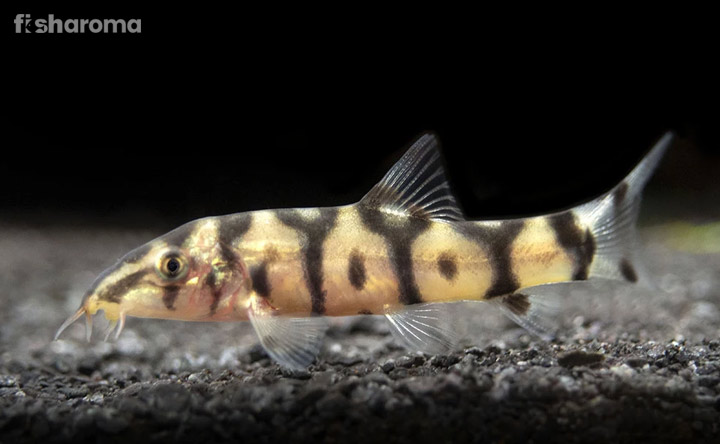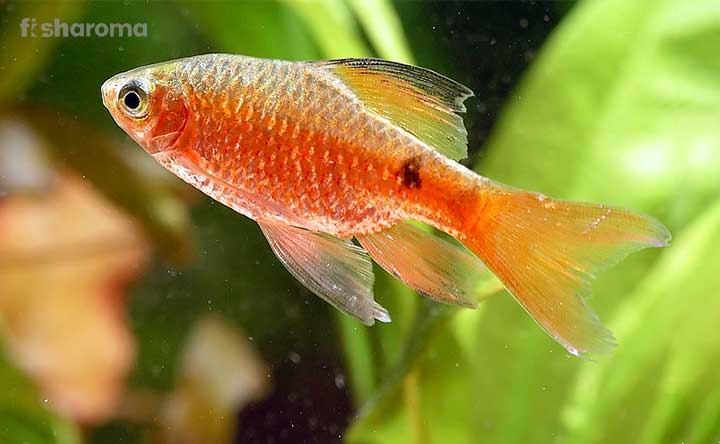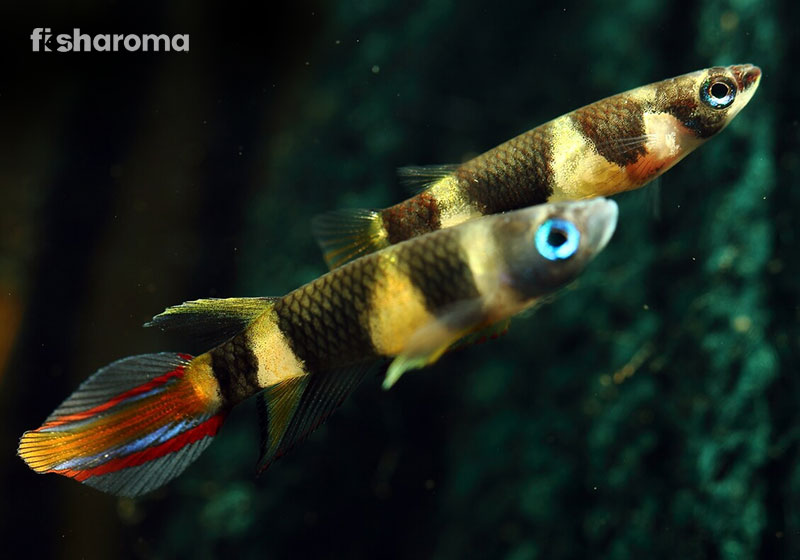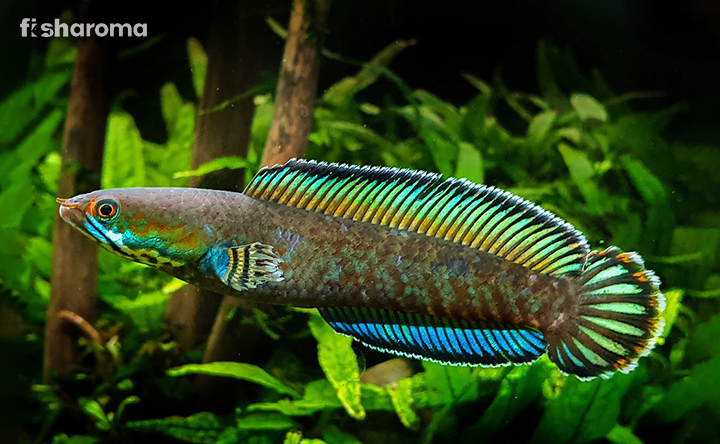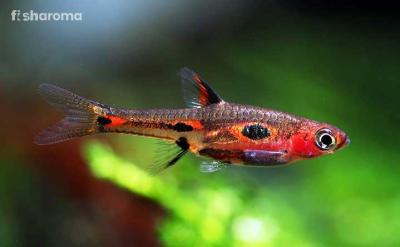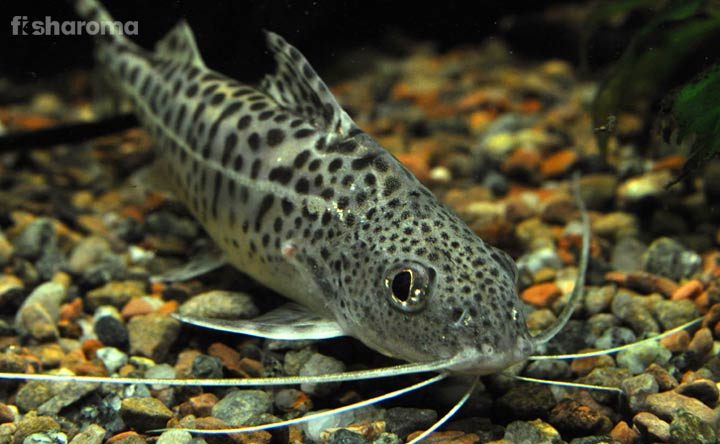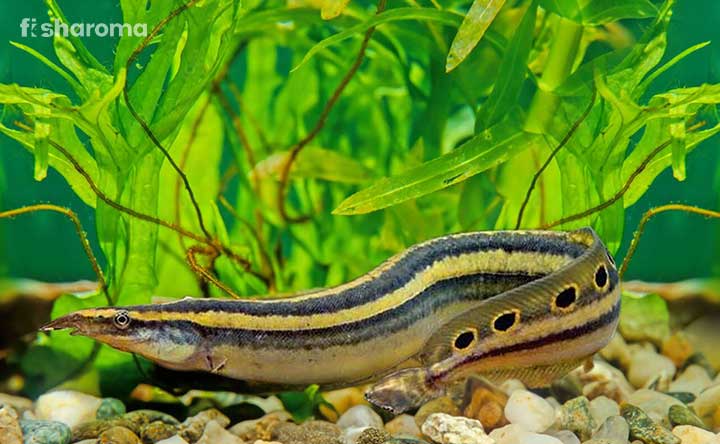Paradise Gourami – The Complete Care Guide of This Aggressive Tropical Fish
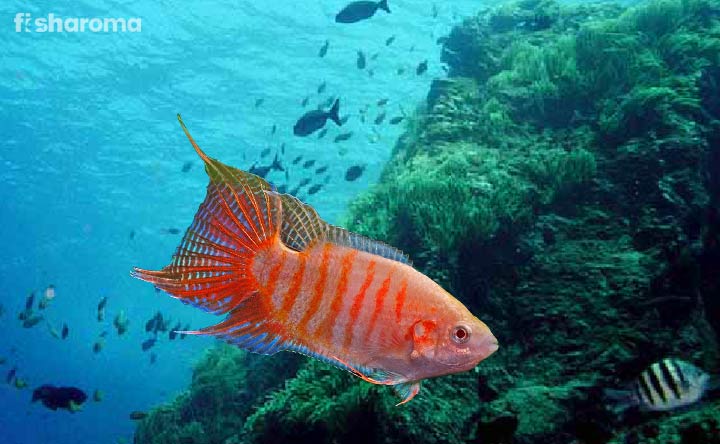
- Origin and Habitat of Paradise Gourami Fish
- Appearance of Paradise Gourami Fish
- Behavior of Paradise Gourami Fish
- Types of Paradise Gourami Fish
- Lifespan of Paradise Gourami Fish
- Diet of Paradise Gourami Fish
- Tank Requirements of Paradise Gourami Fish
- Water Type for Paradise Gourami Fish
- Compatibility of Paradise Gourami Fish
- Breeding of Paradise Gourami Fish
- Common Diseases of Paradise Gourami Fish
- Difficulties in Petting of Paradise Gourami Fish
- Summary
Paradise Gourami Fish or Paradise Gourami is one of the most glamorous and eye-catchy water buddies among the fish keepers. Relaxing on the couch and seeing this stunning red-blue striped fish in color-changing LED aquarium lights can be truly blissful. As it is known for its sporty and aggressive nature, keepers often face difficulties in handling it. So, if you want to grow a healthy fish and handle this aggressive little buddy like a pro, you have to go through this article.
Key Specifications of Paradise Gourami Fish
Before going into its detailed care guide, let’s have a look at the quick details of this fish…
| Scientific Name | Macropodus opercularis |
| Family | Osphronemidae |
| Origin | Southeast Asia |
| Size | 4-6” (10-15cm) |
| Color | Red or orange and Blue stripped |
| Care Level | Easy |
| Lifespan | 6-10 years |
| Temperament | Aggressive |
| Compatibility | Low |
| Tank Size | 20 gallons |
| Diet | Omnivore |
Overview
Paradise Fish (Paradise Gourami) is the second most popular Gourami that comes right after Pearl Gourami. In every South-East Asian country, these are available in large numbers. It is said to be the first tropical fish for aquarium. It was imported to Europe almost 150 years ago, and the long flowing fins made them an eye-candy for all.
Also, these are described as “the beautiful beasts” which indicates its dazzling beauty along with its aggressiveness.
Origin and Habitat of Paradise Gourami Fish
It is a small yet beautiful fish which is known as Paradise Gourami, Blue Paradise Fish, Paradise Gourami, Paradisefish, Blue Paradise Gourami, and Red and Blue Paradise Fish. They are available in large numbers in India, Pakistan, Taiwan, Japan, North-East Laos, Cambodia, Malaysia, Korea, Northern, and Central Vietnam, the Ryukyu Islands and last but not least China. From the Yangtze River basin to the Pearl River basin of Hong Kong is known for the availability of this fish.
You will be able to find them in bogs and paddy fields of South East Asia. The shallow lakes of the coastline areas are the preferred places of them. There is a possibility that these particular species prefer moderate to the cold temperature of the coastlines.
Though these are originally from South East Asia, one can find it outside Asia. Presently, Madagascar and the US are known for the wide population of them. It is available in Paris too. As the demand for this fish among fish keepers is increasing globally, scientists are getting more interested in this fish and trying to breed the fish outside Asia. This is why the number of this fish is increasing worldwide. It means you will not face any problem in getting or breeding this fish irrespective of your location.
Appearance of Paradise Gourami Fish
The main reason for the attraction of this fish is its colors which get intensified at the time of breeding. The contrast of bright and dark colors along with flowing fins adds charm to their appearance. Fish keepers try to keep the fish which will enhance the beauty of their aquarium and it is undoubtedly one among them.
It has a rounded neck and a sleek body. The shape of the caudal fin is different in different types. Mainly it is forked, and some other types of this fish have round and pointed fin. According to the design and color of the tails, the flowing and forktail one has the highest demand among the fish keepers.
Size of Paradise Gourami Fish
It is small and playful fish which initially come in 1-2” (2-5 cm) and if you provide a healthy aquarium, it will grow up to 4-6” (10-15 cm).
Color of Paradise Gourami Fish
They generally have a vibrant red hue with blue stripes across their bodies, but their fins have only one color (reddish-orange). Orange or brownish or greenish-brown body with green stripes is commonly seen in the young ones. You can find black or blue spots on their bodies. The color of the adult fish is generally darker than the young ones. A proper aquarium condition will intensify the color.
Breeders, now with the help of technologies, are producing solid red and solid blue Paradise Gourami Fish. Also, an Albino variant (pink, creamy white with blue stripes) and a concolor variant (black) are the two latest inclusions in them.
Behavior of Paradise Gourami Fish
It is generally a peaceful aquarium fish, but it is aggressive with small and same sized tank mates. They are extremely dominant to others which means they can do physical damage to others. The chances of a fight for territory are extremely high among them. It can also damage the tank decors as they try to swallow everything.
Also, they tend to hunt. Therefore, any small fish are considered as their food.
During fights, they jump on their rivals and open up their operculum. Then they extend their fins and change the color to threaten the rival. You need a little knowledge to select their tank mates.
Types of Paradise Gourami Fish
Depending on the structure of the tails, they can be of three types.
Forked Tail Paradise Gourami Fish
Forked tail Paradise Gourami Fish or Macropodus opercularis is the most popular one for keeping in aquarium. This one is considered as the most beautiful fish due to the structure of their tails.
Rounded Tail Paradise Gourami Fish
Rounded Tail Paradise Gourami Fish or Macropodus chinensis comes in the second place in the popularity scale. The round shape of the tail makes a difference with other aquarium fish, and it attracts the eyes of fish keepers easily.
Spikedtail Paradise Gourami Fish
The structure of Spikedtail Paradise Gourami Fish or Macropodus cupanus is definitely very common due to its pointed tail, but unlike other pointed tail aquarium fish, several rays starting from the middle and fading towards the points of the tail can be seen in them.
Lifespan of Paradise Gourami Fish
They generally live longer than most of the aquarium fish and its average lifespan is 6-10 years. It is suggested to start breeding when they are four years old.
At the time of breeding, they need to be healthy and to raise the fry to a healthy adult fish, you need to follow diet and tank and water arrangements mentioned below.
Diet of Paradise Gourami Fish
They live on an omnivorous diet, and you must feed them high protein foods. A combination of plant materials along with insect protein will be ideal for them. Live and frozen foods along with dry foods and flakes will also be nutritious for them. When it is extremely hungry, it will clean up the algae of your aquarium too. You can feed them:
- Algae wafers and flakes like Fluval Bug Bites, Zoo Med Spirulina
- Pellets ( HIKARI Micro Pellets, API Fish Food Pellets)
- Freeze-dried veggies and fruits
- Freeze-dried worms
- Daphnia
- Small aquatic insects
- Dead flies
- Bloodworm
- Tubefix Worm
- Mosquito Larvae
- Small insects (Live or Frozen)
- Brine Shrimp
- White Worms
In their natural habitat, they consume Planktonic Invertebrates, and Zoobenthos and their tendency of hunting on the prey can be seen whenever you will feed them live foods. At the time of breeding, feed the females first as they will not intake any food at the time of holding the eggs.
You can feed this fish twice a day and make sure each time your fish can finish the food within two minutes.
Tank Requirements of Paradise Gourami Fish
In order to raise a healthy fish, along with a nutritious diet, you need to take care of the tank as well. Keep this in mind that you are taking out the fish out of its natural habitat, so you need to replicate its natural habitat in your aquarium.
Tank Size
A 20-gallon tank is a minimum requirement for them. If you are planning to keep a small fish in a 5-Gallon Tank, it will not be a problem at the initial stage, but in its adulthood, an adequate place will be required.
They are very sporty, and they swim almost all day, so a small tank will not be enough for them. If you are planning to keep them with others, go for a 30-gallon tank. For a single male one, you can opt for a 20-gallon tank.
Tank Lid
A tight lid for the tank is mandatory as they are avid jumpers.
Substrate
Sand will help you to replicate the natural habitat of them. It will help the fish to dig hiding places too. Small rocks and caves will also be good for them as well.
Aquatic Plants
Aquatic plants will also help the fish to hide from their enemies. However, they are known for eating these plants too. You can select hardy plants such as Hornwort for this purpose.
Do not cover the aquarium surface with plants. Keep a little place so that the Paradise Gourami Fish can continue to swim up to surface and take oxygen directly from air using labyrinth organ.
Filter
It is very adjustable by nature. They can endure almost all tough conditions, but this may reduce their lifespan. So, you must keep the aquarium clean. Install the filters to remove the uneaten food and fish wastes. If you don’t want filters, you need to do manual cleaning each week.
Pumps are not required as high or low current are unnecessary for Gouramis. They live in no current areas, and they can inhale oxygen from the air.
Lighting
Using LED lights will be the best and cost-effective here. Also, this light will create a great ambience in the aquarium.
Well, that’s about the aquarium adjustments, now have a look at the water parameters.
Water Type for Paradise Gourami Fish
Paradise Gourami Fish has the least demands regarding water adjustments; they can survive in the least or no water management, but it can make them unhealthy. You need to make the minimum adjustments in the aquarium water so that your fish face the least problem to survive. Take a look.
Temperature
65°-84°F (19-30°C) temperature will be suitable for them. Heat and cold tolerance level in them is generally higher than others, but below 65°F (19°C) or above 84°F (30°C) is not acceptable. At the time of breeding, keep the temperature between 70°-75°F (21-23°C).
pH Level
Just like any other freshwater fish, pH level of the tank water needs to be 5.8 to 8.
Hardness
5 – 30 dGH is the ideal water hardness for them.
Nitrate Level
Nitrate level has to be zero or extremely low to keep the fish healthy.
Cleaning Methods
Use of soap or chemicals is restricted, but you can use store-bought solutions.
Replacement Procedure
Partial water change (25%) is required each week, and it will help them to cope up with the changes.
Compatibility of Paradise Gourami Fish
Due to the aggressive nature, it is recommended not to keep two male ones in a tank as they will hurt each other. One male and one or more female ones will be compatible. Females are also more compatible and less aggressive than males.
For their aggression, choosing tank mates is a bit difficult for them and aquarists prefer to keep them alone. They physically attack the small and same-sized fish and damage their fins, but they don’t mess with large ones. Take a look at their suitable and unsuitable tank mates.
Suitable Tank Mates of Paradise Gourami Fish
Due to their aggression, it will be good to keep larger fish with Paradise Gourami Fish. Species that are compatible with them are as follows:
- Comet Goldfish
- Giant Danios
- Geophagus Cichlids
- Armored Catfish
- Cuckoo Catfish
- Pearl Gouramis
- Large Characins
- Dwarf Gouramis
- Bristlenose Pleco
- Large Synodontis Catfish
- Bala Sharks
- Clown Loach
Unsuitable Tank Mates of Paradise Gourami Fish
All the slow swimmers and fish with long flowing fins are unsuitable to stay with this fish. The following species are incompatible with them:
- Fancy Goldfish
- Angelfish
- Discus Fish
- Neon Tetra
- Guppies
- Bettas
- Snails
- Crabs
- Shrimps
Breeding of Paradise Gourami Fish
Before breeding, keep the male and female in good condition separately and feed them with healthy live and frozen foods in less quantity several times a day. Females will appear plump as they will start filling out with eggs after feeding.
At this stage, they should be met in a breeding tank with adequate aquatic plants. They are also the bubble nest builders, and males blow bubbles that go up to the surface and form a nest by joining more bubbles. A durable nest attracts the females to lay eggs where the eggs will be secured.
After forming the nest, the males will start courting the females and embrace the females so that the eggs can be fertilized when the females release them. It may take a few minutes to a few hours to lay all the eggs which go up directly in the bubble nest. After spawning is done, remove the female from the tank as males become extremely aggressive to them. Males will take care of the nest and eggs. Alternatively, you can use a 10-gallon breeding tank for hatching.
Eggs may take 1-4 days to hatch. After hatching, remove the male fish as they tend to eat the fries. You can feed baby Brine Shrimps or micro worms to these hatched fries.
Common Diseases of Paradise Gourami Fish
As they can survive in tough conditions, fish keepers are often very negligent in taking care of them. As a result, some diseases are commonly seen in them. They are as follows:
| Diseases | Symptoms | Causes | Remedies |
| Fin Rot | Disintegration of fins. The end of the fin becomes reddish. | Bacterial microbes named Pseudomonas and Aeromonas which grow in cold and dirty water. | Provide antibiotics like tetracycline and ciprofloxacin. |
| Dropsy | Swollen belly. | Malnutrition. Infections caused by Pseudomonas. | Provide antibiotics like Kanamycin and Maracyn-2. Apply aquarium salt. Clean up the aquarium. Partial water change. |
| Swim Bladder Disorder | Fish swims upside down. Fish sinks to the bottom of the tank. | Overeating. Poor water and aquarium condition. | Let the fish starve for 2-3 days. Lower the temperature. Slightly feed one boiled pea a day for a few days. |
| Camallanus Worms | Lethargy. Swollen belly. | Parasite. | Provide Fenbendazole solution along with soaked flakes. |
| Lymphocystis | Breathing trouble. Nodules on skin and fins. | A virus of Iridoviridae family. | Terminal disease with no cure. Take care of everything and be a good observer to reduce the chance of health damage. |
Difficulties in Petting Paradise Gourami Fish
Due to a wide choice of foods and least aquarium and water adjustment demands, the difficulty level in keeping them is lower than most other aquarium fish. Beginners can also keep this fish easily. But a fish keeper needs to be selective at the time of choosing tank mates.
Summary
It is truly majestic due to its looks and nature, but due to its compatibility issues with most of the aquarium fish, keepers often avoid this. Hopefully, this guide can convince you that it is not that difficult to keep a Paradise Gourami Fish; rather, caring for this one is comparatively easier than others. Most importantly you don’t need strict adjustments in aquarium and water parameters plus you will get so many food options for them as well. By following this care guide, you can raise a healthy one with minimum effort.
- Samuel Pepps in 1965 introduced Paradise Gourami Fish in an aquarium and it was the second pet fish right after the Common Goldfish.
- In its natural habitat, they have similar patterns like the Dwarf Gourami and Giant Gourami.
- The color of these fish changes according to their moods, breeding interests, and water temperature. You can learn about their health observing their color change.
Know More about Freshwater Fish
Here are some other care guides of freshwater fish you may like to know
- Celestial Pearl Danio: Know about the diet, water and aquarium parameters and more of beautiful pet fish called Celestial Pearl Danio.
- Clown Loach: Get a complete care guide of the freshwater beauty – Clown Loach.
- Red Tail Shark: Seeing a look-alike of a shark in your aquarium is a delight. Know everything to grow a healthy Red Tail Shark.

